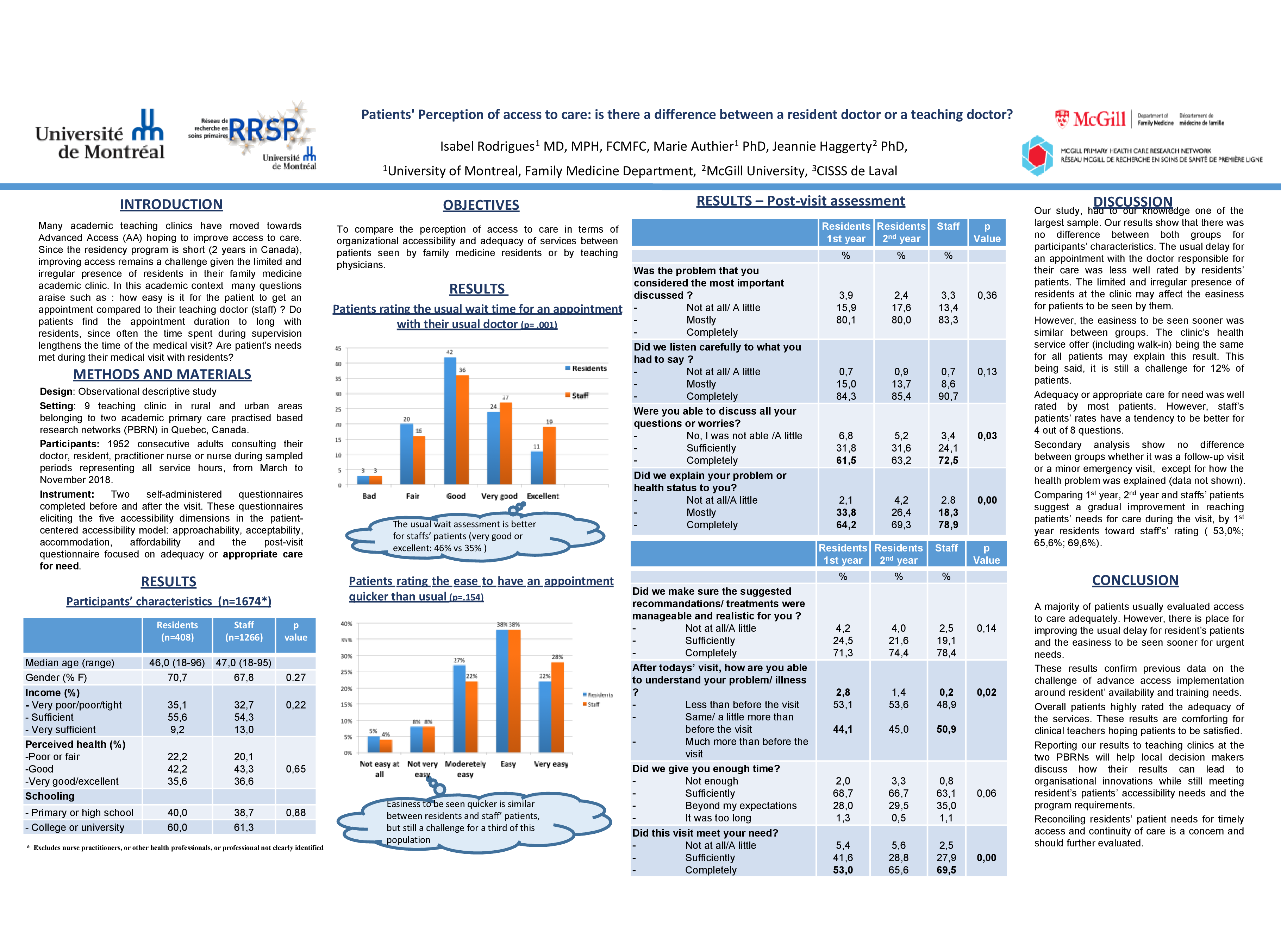PCR048: Patients' Perception of access to care: is there a difference between a resident doctor or a teaching doctor?
Isabel Rodrigues, MD, MPH, MPH; Marie Authier, PhD
Abstract
Context Many academic teaching clinics have moved towards Advanced Access (AA) hoping to improve access to care. Since the residency program is short (2 years), improving access remains a challenge given the limited and irregular presence of residents in their family medicine academic clinic. Some published studies have compared patient’s satisfaction on punctual services provided by resident’s but no studies focused on patient’s perception of access to care relative to the type of professional responsible for their care.
Objective To compare the perception of access to care in terms of organizational accessibility and adequacy of services between patients followed by family medicine residents or by teaching physicians.
Method Design: Cross-sectional patient survey. Setting: Nine Teaching clinics in rural and urban areas in Quebec, Canada. Participants: 1954 adults consulting during sampled periods representing all service hours. 81 % answered the post-visit questionnaire. Instrument: Self-administered questionnaire with validated subscales measuring approachability, accommodation, affordability and appropriate care for need. Results:There was no difference for most of patients’ characteristics between both groups. The usual delay for an appointment was rated very good or excellent for staffs patients 46% vs 35 % and 18% of staff’s patients’ vs 23% rated it as poor (p 0,001).The easiness to be seen sooner was rated moderately to not very easy for 34% of staff’ patients compared to 40% of resident’s patient’s (p=0.13). Overall patients were very satisfied with the services received in terms of being able to discuss the most important problem, perceiving being listened to, having enough time during the appointment, and having their needs met after today’s visit. 2nd year residents achieved comparable results to staff for 5 out of 8 questions and achieved significantly better results when compared to first year residents, some times reaching a 10 % higher results in the best choice column.Conclusion Even if a majority of patients usually evaluated access to care adequately, there is place for improving the usual delay for resident’s patients and the delay for urgent needs. Overall patients highly rated the adequacy of the services. As the resident progresses into the second year, the improvement in the patient’s perceived fit between their needs and the services received reflects on trained residents becoming ready for a competent and independent practice.
Objective To compare the perception of access to care in terms of organizational accessibility and adequacy of services between patients followed by family medicine residents or by teaching physicians.
Method Design: Cross-sectional patient survey. Setting: Nine Teaching clinics in rural and urban areas in Quebec, Canada. Participants: 1954 adults consulting during sampled periods representing all service hours. 81 % answered the post-visit questionnaire. Instrument: Self-administered questionnaire with validated subscales measuring approachability, accommodation, affordability and appropriate care for need. Results:There was no difference for most of patients’ characteristics between both groups. The usual delay for an appointment was rated very good or excellent for staffs patients 46% vs 35 % and 18% of staff’s patients’ vs 23% rated it as poor (p 0,001).The easiness to be seen sooner was rated moderately to not very easy for 34% of staff’ patients compared to 40% of resident’s patient’s (p=0.13). Overall patients were very satisfied with the services received in terms of being able to discuss the most important problem, perceiving being listened to, having enough time during the appointment, and having their needs met after today’s visit. 2nd year residents achieved comparable results to staff for 5 out of 8 questions and achieved significantly better results when compared to first year residents, some times reaching a 10 % higher results in the best choice column.Conclusion Even if a majority of patients usually evaluated access to care adequately, there is place for improving the usual delay for resident’s patients and the delay for urgent needs. Overall patients highly rated the adequacy of the services. As the resident progresses into the second year, the improvement in the patient’s perceived fit between their needs and the services received reflects on trained residents becoming ready for a competent and independent practice.

Jack Westfall
jwestfall@aafp.org 11/20/2021This is a great topic and research study. Nice work. Thanks